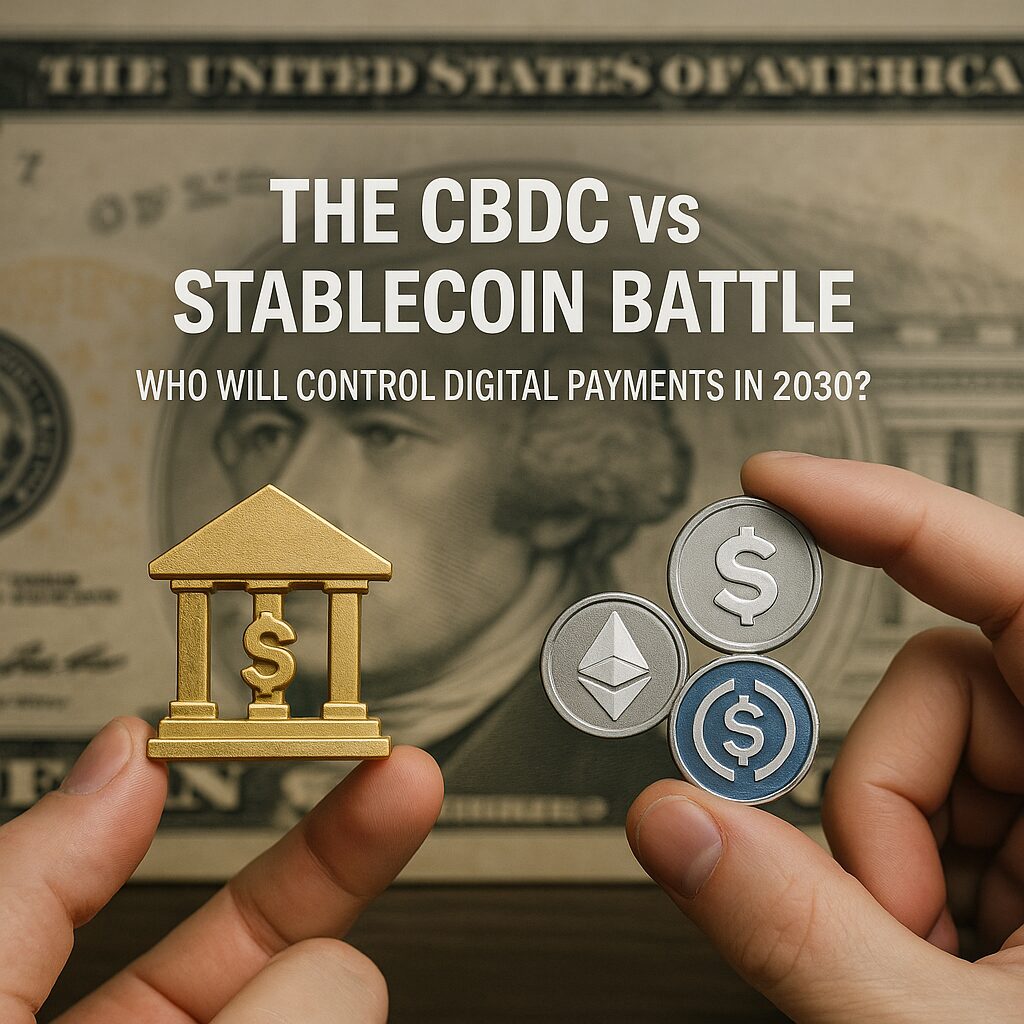Who Will Control Digital Payments in 2030?
📌 Will Governments Win the Digital Currency War?
As CBDCs gain momentum and stablecoins become more powerful, the fight for control of digital payments is heating up. In this post, we compare state-issued digital currencies and decentralized stablecoins to predict who will dominate by 2030.
The race to dominate digital payments is no longer just between tech startups and crypto enthusiasts. It’s now a full-scale global conflict between governments issuing Central Bank Digital Currencies (CBDCs) and private entities issuing stablecoins like USDC, USDT, and DAI.
This article explores the key fronts of this battle—trust, technology, privacy, cross-border usage, monetary control, and what this war means for the future of money.
1. The Stakes: Power Over the Global Financial System
- CBDCs are issued by central banks. Their purpose: to modernize money, improve control over monetary policy, and compete with digital assets.
- Stablecoins, meanwhile, are typically backed by reserves and issued by private companies—but they’re gaining adoption faster, particularly in emerging markets.
At stake is who controls the plumbing of global commerce in the coming decade.
2. Trust: State vs Protocol
CBDCs enjoy legal backing but face trust deficits among citizens:
- Fears of surveillance and financial censorship are high.
- In China, the e-CNY includes programmable features that can restrict how money is spent.
Stablecoins, despite being issued privately, are more trusted among crypto-native users because of:
- Transparent blockchain records
- Open-source architecture
- Access through decentralized wallets (like MetaMask)
Verdict:
Governments have the law. Stablecoins have the people—at least for now.
3. Technology: Agility vs Bureaucracy
CBDCs rely on state-run infrastructure, which often moves slowly:
- Pilot programs (like the digital euro or e-naira) face tech hurdles and adoption delays.
- They may not integrate easily with DeFi, NFTs, or Web3 platforms.
Stablecoins are:
- Already operating across chains (Ethereum, Solana, Avalanche, etc.)
- Plugged into hundreds of apps—from wallets to games to lending protocols.
Verdict:
Stablecoins are ahead in interoperability, developer tools, and use-case integration.
4. Privacy: The Most Critical Battlefront
CBDCs are programmable—and that makes them powerful and dangerous.
- They can be coded to expire, be spent only on certain goods, or be blocked instantly.
- Governments argue this helps fight crime and enforce policy.
But critics warn:
- CBDCs could be weaponized to enforce social credit systems, tax compliance, or political control.
Stablecoins, especially decentralized ones like DAI, offer more user autonomy.
- They’re censorship-resistant.
- Users can transact without revealing identity (depending on jurisdiction).
Verdict:
Stablecoins protect freedom. CBDCs protect the system.
5. Cross-Border Payments: Friction vs Frictionless
CBDCs are mostly domestic experiments right now. Cross-border CBDCs (like mBridge) are still in sandbox phase.
Stablecoins are:
- Already used for remittances, e-commerce, and global payroll.
- Especially useful in countries with unstable currencies.
Verdict:
Stablecoins are years ahead in borderless adoption.
6. Monetary Policy Control
CBDCs give central banks real-time control:
- Instant data on money flow
- Direct issuance of stimulus or taxation
- Precision tools for monetary adjustments
Stablecoins bypass this entirely. They:
- Remove intermediaries
- Can’t be recalled or frozen without cooperation
- Create “dollarized micro-economies” within local financial systems
Verdict:
Governments want CBDCs to reclaim control from private money.
7. Legal and Regulatory Momentum
Governments are creating legal pathways for CBDC adoption:
- EU: Digital Euro framework
- US: Ongoing discussions under the Fed and Treasury
- Asia: China, India, and Korea are leading CBDC rollouts
At the same time, they’re tightening stablecoin rules:
- Requiring KYC/AML for issuers and wallets
- Limiting algorithmic models (post-Terra collapse)
- Demanding reserve audits
Verdict:
Regulation is CBDC’s best weapon and stablecoin’s biggest vulnerability.
8. Adoption Patterns: Voluntary vs Mandated
CBDCs will likely be:
- Mandated by law, tied to tax systems, and encouraged through incentives.
- Used in public sector (e.g., salary payments, welfare).
Stablecoins are:
- Adopted organically—by crypto users, freelancers, DAOs, and remote teams.
- Already present in DeFi protocols, exchanges, and blockchain games.
Verdict:
CBDCs will force adoption. Stablecoins will earn it.
9. What Happens by 2030?
Multiple scenarios are possible:
| Scenario | Description | Winner |
|---|---|---|
| Dual System | CBDCs for domestic control, stablecoins for global use | Tie |
| Total Regulation | Governments outlaw stablecoins | CBDCs (short-term win) |
| Decentralized Victory | Crypto-native ecosystems thrive despite CBDCs | Stablecoins |
| Hybrid Models | Regulated stablecoins with state oversight | Shared power |
What’s most likely: a hybrid future where:
- CBDCs dominate state transactions and infrastructure
- Stablecoins dominate digital finance and decentralized commerce
10. How to Prepare as a User or Investor
- Diversify: Hold exposure to both CBDC-compatible platforms and stablecoins
- Understand Wallet Risk: CBDCs may require custodial apps; stablecoins allow private keys
- Stay Informed: This battle is evolving fast—subscribe to trusted crypto regulation updates

